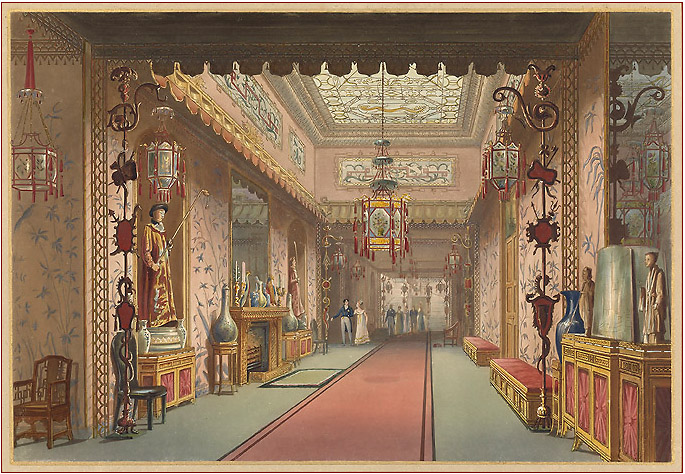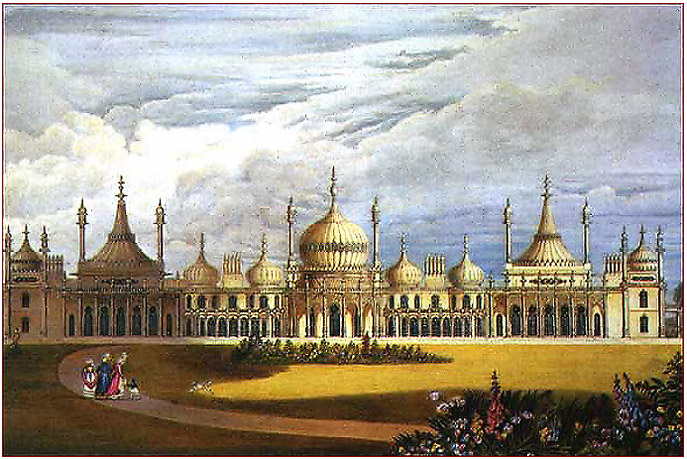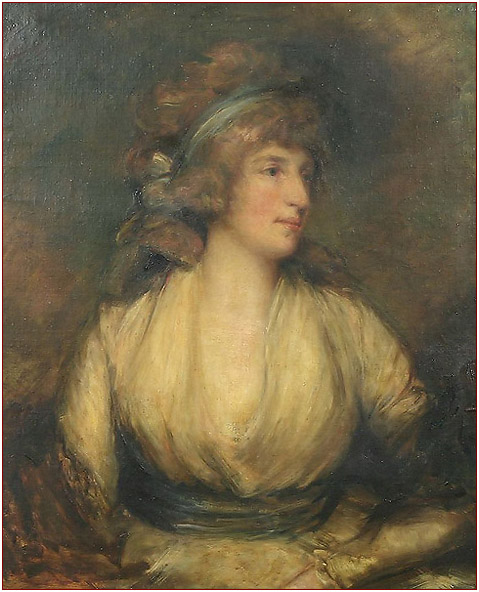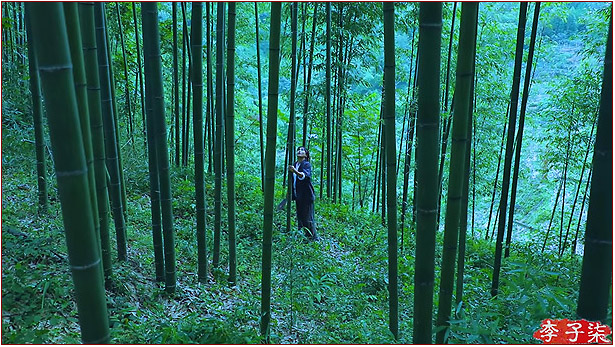|
For this rather small chair, there is a rather 'exotic' story.
If you recall, England had set up trade with China and India about 1600.
To the English, the "East" represented all that was mysterious and exotic -
first with ceramics, silks and spices -
then soon with furniture and wallpaper - and of course - tea
In the 1700s, England's Thomas Chippendale even
"married" Chinese and French motifs in furniture design.
All finer homes in Britain procured treasured selections of
"Chinoiserie" -
be it furniture, porcelain, or wallpaper.
However, the one who became completely obsessed with the Chinese style was
George IV, the eldest child of George III.

Unlike his father, George IV is described as being
wildly extravagant with food, drink, the ladies, as well as his taste in decorating his palaces.
As early as 1801, the Prince had been completely taken by Oriental tastes
and began to expand his existing coastal Brighton retreat.
Having been presented a gift of Chinese wallpaper,
he ordered a
"Chinese Gallery" (below)
to display the new paper.
The 162-foot long
Chinese "passage room" was contrived of painted glass decorated with
flowers,
insects, fruit and birds. And in 1802, the
"Chinese Gallery"
was further furnished with
"bamboo furniture"...
... some of Chinese manufacture in bamboo, and others "after"
English imitations, sent to China for copying "exuberantly" in bamboo or beechwood.

("...the Chinese Gallery (above, as it originally was) contains a multitude of generic Chinese/Asian features
('Chinoiserie'), including the hexagonal lanterns, the silk tassels and the motif of bamboo and birds on the
wallpaper, the work of interior decorator Frederick Crace.")
The Prince's desire for additional structures in the Oriental manner resulted in commissioning the
famous and "overly fashionable"
John Nash as architect, and Frederick Crace for Oriental interiors -
to create his "dream" - the "Royal Pavilion",
all of Moorish, Tartar, Gothic, and Chinese elements -
including domes, tents and minarets - and supported by iron and stone.
A dominant theme for the Pavilion interior was, in fact,
"the imitation of bamboo"-
including the cast iron staircase, the wallpapers - even the moldings.

'The Garden Front of the Royal Pavilion in Brighton',
from John Nash's
"Views of the Royal Pavilion" (1826).
Such was the allure of "Chinese bamboo" in early 19th century Great Britain.
And such was bamboo's strong influence upon British furniture during that same period :
Fine George III Rosewood &Mahogany 'Quartetto' Nest of Tables
England, c1810, as pictured in George Smith's 1808 "Household Furniture",
as well as MacQuoid & Edwards, "Dictionary of English Furniture, Tables, Fig, 22",
(the quartetto on offer by this gallery)
But ... there is a further - and romantic - aspect to Brighton Pavilion.
A 1976
"New Yorker" prints this report :
"... By 1785, 'Prinny' (as he was also known) had managed to run
up staggering debts, and make
a morganatic marriage*. As London became too hot for him, he and his 'wife', Maria Fitzherbert,
rented and then bought a simple farmhouse in the small fishing
village of Brighton.
This he expanded to a modest (by his standards) Palladian
villa."
The debts increased to a point that Parliament insisted that he
"officially marry
a suitable European princess" to pay off his debts.
"When Prinny obliged, Mrs. Fitzherbert left him and their pavilion.
The official marriage was not a success and, by 1800,
he and his princess had agreed to live apart.
And Mrs. Fitzherbert returned in triumph to the pavilion.
To celebrate her return, the prince regent had the pavilion enlarged
and the whole place redecorated in an orgy of Oriental opulence".
There are reports that differ somewhat from this story.
However, it known that despite other liaisons and affairs,
when in 1830 George IV died, he requested
the locket with the portrait his "secret wife", Maria Fitzherbert,
to be buried with him.
It is said that when Maria Fitzherbert was told of his choice - she wept.

"Portrait of Mrs. Maria Fitzherbert (1756-1837), wife of George IV"
Linked below is a YouTube video beautifully illustrating the time-honored yet simple
craftsmanship involved in the making of bamboo furniture

Li Ziqi (Lǐ zǐ qī - 李子柒) constructs a bamboo sofa-set,
from the harvesting of bamboo through completion and use.
Of most interest are the techniques used to split and bend the bamboo trunk
in the assembly of these amazingly sturdy structures.
(6:45 minutes)
https://www.youtube.com/watch?v=LTejJnrzGPMv
There is an unmistakable charm and history to early
CHILDREN'S FURNITURE
We try to keep a few pieces from the late 17th to early 19th century in stock.
Click above link if you wish to view.
|